Western Digital Stuns Storage Industry with MAMR Breakthrough for Next-Gen HDDs
by Ganesh T S on October 12, 2017 8:00 AM ESTScaling Hard Drive Capacities
Hard disk drives using magnetic recording have been around for 60+ years. Despite using the same underlying technology, the hard drives of today look nothing like the refrigerator-sized ones from the 1960s. The more interesting aspect in the story is the set of advancements that have happened since the turn of the century.
At a high level, hard disks are composed of circular magnetic plates or 'platters' on which data is recorded using magnetization and the patterns of magnetization represent the data stored. The patterns are laid out in terms of tracks. They are created, altered and recognized with the help of 'heads' mounted on an actuator that perform read and write operations. Modern hard disks have more than one platter in a stack, with each platter using its own individual 'head' to read and write.
There are additional hardware components - the motor, spindle, and electronics. The segment of interest from a capacity perspective are the platters and the heads. The slide below shows two ways to increase the capacity of a platter - increasing the number of tracks per inch (TPI) and/or increasing the number of bits per inch (BPI) in a single track. Together they yield a metric for areal density, which the industry gives as a value in bits per square inch, such as gigabits per square inch (Gb/in2) or terabits per square inch (Tb/in2).
Hard drives in the early 2000s primarily relied on longitudinal recording, with the data bits aligned horizontally in relation to the spinning platter - this is shown in the first half of the image below. One of the first major advancements after the turn of the century was the introduction of perpendicular magnetic recording (PMR) in 2005.
At the time PMR made its breakthrough, Hitachi commissioned an amusing video called 'Get Perpendicular', which was used to demonstrate this technology and reaching 230 gigabits per square inch. The video can be found here.
PMR was developed as a solution to the previous areal density limits of around 200 Gb/sq.in caused by the 'superparamagnetic effect' where the density of bits would cause the bits to flip magnetic orientation and corrupt data. PMR, by itself, can theoretically hit around 1.1 Tb/sq.in.
Alongside PMR, more technologies have come into play. The most recently launched hard drives (the Seagate 12TB ones) have an areal density of 923 Gb/sq.in. The industry came up with a number of solutions to keep increasing hard drive capacity while remaining within the theoretical areal density limits of PMR technology:
Helium-filled drives: One of the bottlenecks in modern drivers is the physical resistance on the heads by the air around the platters. Using helium reduces that resistance, albeit, with the requirement of sealed enclosures. The overall effect is improved head stability and a reduction in internal turbulence. This allows for a shorter distance between platters, giving manufacturers the ability to stack up to seven in a single 3.5" drive (rather than the usual six). Helium drives were first introduced to the market in 2012 by HGST. The latest helium drives come with as many as eight platters.
Shingled magnetic recording (SMR): In this technology, the track layouts are modified to give overlaps, similar to how roof shingles are laid (hence the name). While this creates challenges in rewriting over areas already containing data (the need to avoid overwriting valid data that has to be retained), there are sub-technologies and methods to mitigate some of these issues. The challenges can be either solved on the host side or the drive side. Seagate was the first to ship drive-managed SMR drives in 2013.
Improvements in actuator technology: In the last few years, Western Digital has been shipping 'micro actuators' that allow for finer positioning and control compared to traditional actuator arms. This directly translates to drives with a higher bit density.
Improvements in head manufacturing: Traditionally, PMR heads have been manufactured using the Dry Pole process involving material deposition and ion milling. Recently, Western Digital has moved to the Damascene process (PDF) that involves a etched pattern filled using electroplating. This offered a host of advantages including a higher bit density.
We had briefly mentioned PMR technology having theoretical limits earlier in this section. Traditional PMR can deliver up to 1.1 Tb/sq.in. with improved actuators and heads. Use of SMR and TDMR (Two Dimensional Magnetic Recording) can drive this up to 1.4 Tb/sq.in.
At those areal densities, the TPI and BPI need to be so high that the media grain pitch (the smallest size that the metallic elements that store individual bits can be) is around 7-8 nm. These small grains present a number of challenges, such as the head not being capable of creating a strong enough magnetic field for stable recording.
One solution to this would be to make it easier to write the data to the grain. Decreasing the resistance to magnetization (technically, lowering the coercivity), allows the head's field to modify the magnetic state of the grain. This requires extra energy, such as thermal energy, to be directly applied to the grain for the short amount of time that is needed to write a bit. This is the point where the 'energy-assist' aspect comes into the picture.
Over the last several years, a lot of focus has been on heat-assisted magnetic recording (HAMR), where the lowered resitance (coercivity) is achieved by locally heating the grains using a laser. This brings in a number of concerns that have prevented mass production of drives based on HAMR technology.
MAMR, on the other hand, uses microwaves to enable recording. A primary reason for MAMR not being considered as a viable technology by industry analysts so far was the complexity associated with designing a write head to include a microwave generator. In the next section, we take a look at how Western Digital was able to address this.


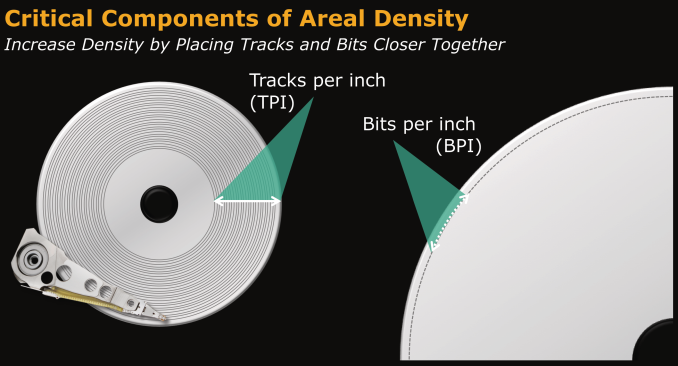
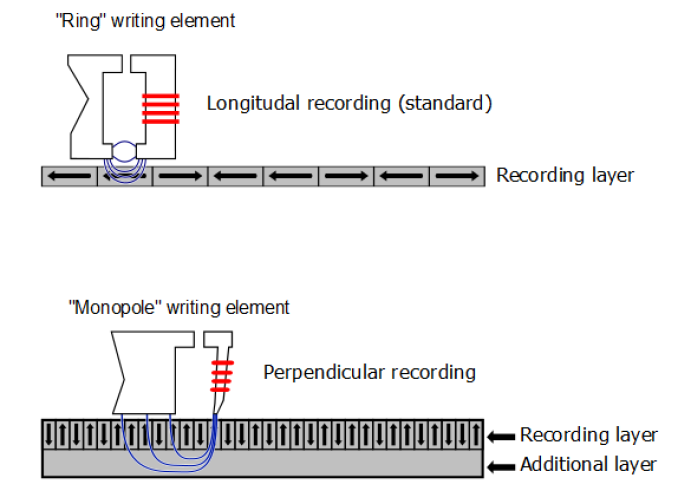
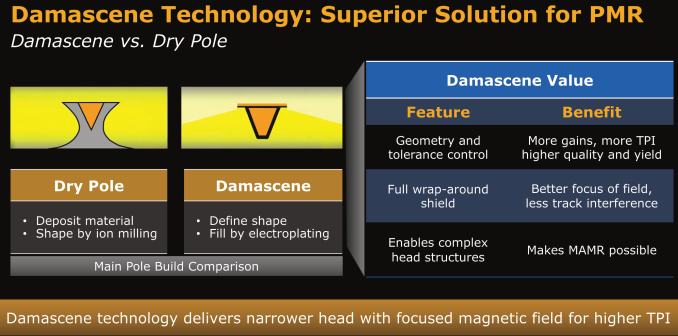
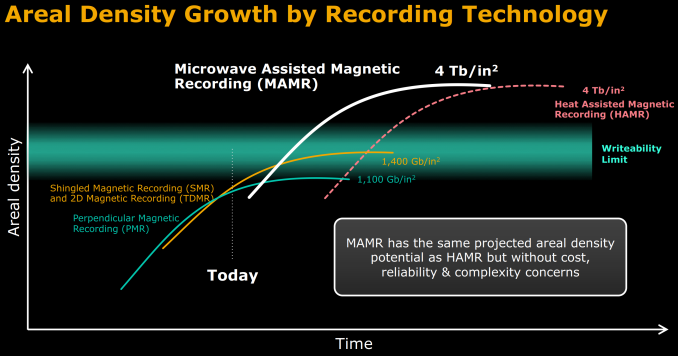
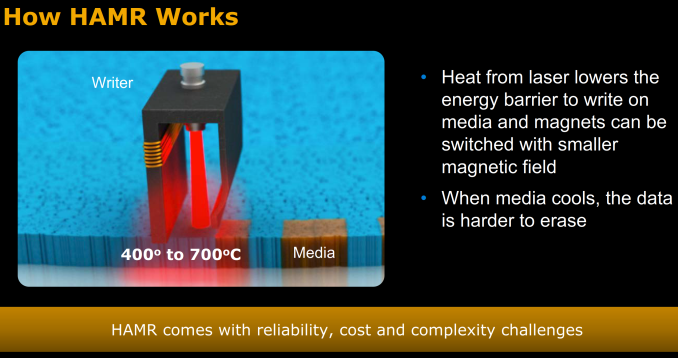








127 Comments
View All Comments
DanNeely - Thursday, October 12, 2017 - link
This's a pleasant surprise (cheaper bulk storage is always a win). Projections I'd seen from a year or two ago were projecting a mid 2020's point for flash becoming cheaper per TB than HDDs. I assume the high expected cost for HAMR was probably a major driving factor in those projections. If MAMR really will be as cheap to implement as current PMR solutions it's good news all around.MajGenRelativity - Thursday, October 12, 2017 - link
Agreedjjj - Thursday, October 12, 2017 - link
WD used to lie a lot less than others but those HDD vs SSD projections are hilarious, new CEO ,new habits i suppose.SSDs will go after nearline soon enough as they'll need to do that to offload all the bits produced.
Anyway, interesting tech but too late to matter much and that's a pity.
melgross - Thursday, October 12, 2017 - link
It's going to take a heck of a long time before SSDs come close to the costs of HDD.While HDDs seem to have newer tech to enable more storage in the same space, SSD is relying on multilayering, which is now 64, but moving to 72. The idea of using smaller process diminution has ended, unless some unknown breakthrough occurs, which we can't expect, because there's nothing known to have us expect one. How many layers can be made? At some point, it won't be possible to go any higher.
But MAMR was understood to be a slight possibility, and WD has made that breakthrough. There's no reason to believe that the 40TB by 2025 shouldn't be believed since preproduction sampling will be next year, and production delivery will be in 2019. That's pretty quick.
Lolimaster - Thursday, October 12, 2017 - link
But 40TB on the top of the line for 2025 is still too low, considering near 10years of PMR stagnation.HAMR was supposed to give us 15-20TB by now, up to 50TB by 2020-2021 and up to 100TB in 2025.
melgross - Thursday, October 12, 2017 - link
Who are you to say it's too low? Are you doing research in this area to know that? Or do you just read articles on it and complain because it's not moving fast enough for you?AnnonymousCoward - Thursday, October 12, 2017 - link
Samsung says 128TB SSD in 2019.beginner99 - Friday, October 13, 2017 - link
The issue with SSDs is that there already is a shortage of flash. Flash is a semi-conductor and hence manufacturing is a bottleneck. Unless a significantly better alternative to flash is found, ssd will remain niche in terms of total storage amounts.someonesomewherelse - Saturday, October 14, 2017 - link
Cartel agreements you mean.shabby - Thursday, October 12, 2017 - link
And I'm sure when these are released they'll still be the same size like the current drives so wd can keep milking everyone.